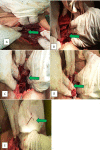Missed Diagnosis of Perforation and Intraperitoneal Migration of an Intrauterine Device and Its Management in a Resource-Limited Setting: A Case Report
- PMID: 38293615
- PMCID: PMC10826545
- DOI: 10.2147/IMCRJ.S441386
Missed Diagnosis of Perforation and Intraperitoneal Migration of an Intrauterine Device and Its Management in a Resource-Limited Setting: A Case Report
Abstract
Background: The intrauterine device is a popular and highly effective form of long-acting reversible contraception. Although generally safe, complications could happen. One of the most serious complications of intrauterine device use is uterine perforation. Risk factors for perforation include, but are not limited to, postpartum period, breastfeeding, levels of experience, and excessive force exerted during insertion. This case is significant because it demonstrates risk factors for uterine perforation, how to handle missing strings, and care in places with little resources.
Case presentation: We discuss the case of a 27-year-old black Ethiopian woman who presented with chronic pelvic pain and had a perforated intrauterine device discovered in the cul-de-sac. The device had been inserted at six weeks postpartum. The client was unable to feel the strings three months after insertion, and a wrong diagnosis of expulsion was made. After one year of insertion, the intrauterine device was located on a plain abdominal radiograph and removed via laparotomy without complications.
Conclusion: Although uterine perforation is a rare complication of intrauterine device insertion, special attention should be paid to women with risk factors. In the absence of a witnessed expulsion, assessments and investigations should be carried out before declaring a device expelled. In patients with chronic pelvic pain complaints in the presence of an intrauterine device, perforation and migration outside the uterine cavity should be considered. Abdominal X-rays and laparotomies can be used to find and manage extrauterine migrating devices in environments with limited resources.
Keywords: intraperitoneal migration; intrauterine device; missed uterine perforation.
© 2024 Gebremichael et al.
Conflict of interest statement
The authors declare that they have no competing interests for this work.
Figures
Similar articles
-
Design of the Association of Uterine Perforation and Expulsion of Intrauterine Device study: a multisite retrospective cohort study.Am J Obstet Gynecol. 2021 Jun;224(6):599.e1-599.e18. doi: 10.1016/j.ajog.2021.01.003. Epub 2021 Jan 15. Am J Obstet Gynecol. 2021. PMID: 33460585
-
Intrauterine device embedded in omentum of postpartum patient with a markedly retroverted uterus: a case report.J Med Case Rep. 2017 Oct 25;11(1):299. doi: 10.1186/s13256-017-1480-3. J Med Case Rep. 2017. PMID: 29065904 Free PMC article.
-
Complications after interval postpartum intrauterine device insertion.Am J Obstet Gynecol. 2022 Jan;226(1):95.e1-95.e8. doi: 10.1016/j.ajog.2021.08.028. Epub 2021 Aug 28. Am J Obstet Gynecol. 2022. PMID: 34461075 Free PMC article.
-
Complete and partial uterine perforation and embedding following insertion of intrauterine devices. II. Diagnostic methods, prevention, and management.Obstet Gynecol Surv. 1981 Aug;36(8):401-17. doi: 10.1097/00006254-198108000-00001. Obstet Gynecol Surv. 1981. PMID: 6455610 Review.
-
Ileal penetration by a Multiload-Cu 375 intrauterine contraceptive device. A case report with review of the literature.Contraception. 1998 Nov;58(5):295-304. doi: 10.1016/s0010-7824(98)00116-4. Contraception. 1998. PMID: 9883385 Review.
References
-
- Katherine D. Intrauterine contraception: management of side effects and complications. Post TW, editor. UpToDate. Waltham, MA: UpToDate Inc; 2018. http://www.uptodate.com. Accessed May 1, 2023.
Publication types
LinkOut - more resources
Full Text Sources



